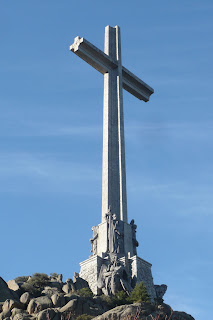This week I visited an old hospital in Alcalá de Henares that was in operation in the 1400s until the early twentieth century. It has now been turned into an apartment complex, but there are some interesting things there, such as an old fount in the wall and the courtyard:
On Saturday, Cody and I went back to El Escorial to visit Valle de los Caídos (Valley of the Fallen), a massive monument in the Sierra de Guadarrama built with the superficial intention of being a resting place for those who died in the Spanish Civil War and a memorial to the conflict. It really serves as a tomb for the dictator, Francisco Franco.
We entered the town of El Escorial once again by train. It was a sunny day, so I took some more pictures of the palace of Felipe II:
From here, we walked down a street toward the bus station where we had to wait a short while for the next bus to Valle de los Caídos, which arrives every two hours. We rode a very nice bus there with a small group of Spaniards and a young French couple. Very few Spaniards like to acknowledge the monument as it is a reminder of the Franco Regime. Francisco Franco was the general of the Nationalists in the Spanish Civil War (1936-1939). The Nationalists were a collection of several far-right groups including monarchists, Carlists (who wanted the church to have a strong involvement in the state), and the Falange (the fascist party of Spain). They were aided by Hitler's Germany, while the opposing side (the Republicans) were aided (somewhat) by the Soviet Union of Stalin. (For this reason, many Spaniards have interpreted the Spanish Civil War as the first stage of World War II. Truthfully, they are two distinct conflicts.) Both sides committed horrible atrocities during the war, but the Nationalists won, resulting in the quasi-fascist dictatorship of Franco which governed Spain until 1975. During the dictatorship, many supporters of the Spanish Republic were imprisoned. Many of them were forced into labor during the construction of the monument (in a natural valley) which began in 1940 and lasted eighteen years. Some sources claim that fourteen forced laborers died during the construction. The bodies of most Republican soldiers who were buried in the valley were moved from the site at this time. The body of José Antonio Primo de Rivera, the founder of the Falange (which became the primary political party of Franco's Spain) was moved here. When Franco died in 1975, he was buried alongside Primo de Rivera. Many Spaniards view Valle de los Caídos as a monument to fascism and refuse to visit or discuss it. Despite this, it is an impressive sight (it can be seen from several miles away) and the location offers an amazing view of the mountains:
The site seems to have been more popular in the past, when Franco was alive and many of his supporters (and those afraid to to offer resistance) along with groups of schoolchildren came to see the monument. There was a restaurant, built in the 1950s style, the only other building nearby, which looked as though it had been abandoned for several years:
The inside of the monument is a basilica in which the bodies of the soldiers are entombed. However, there are no markers for them, only for Franco and Primo de Rivera. This part of the monument was closed for restoration, so I will probably return later to see it. I have heard that the chamber is dimly-lit and several giant statues of faceless angels leaning on swords line the path toward Franco's tomb.
Yesterday, our usual group went for lunch in Alcalá. I had a soup made with cuttlefish and potatoes seasoned with saffron for my first course. It was one of the best soups I have had here. My second course was equally delicious, a piece of roast suckling pig. For dessert, I had a prepared orange, which was split open and covered in a strawberry sauce. Later that night, we had planned on having a Christmas dinner for all of us who work at the school. However, everyone couldn't make it, so we decided to have a big dinner when we get back from Christmas break. Instead, Cody, Jacqui, Emma, and I went to the popular tapas bar, Indalo.
I had today off work, because I switched my Monday for Emma's Friday as she is flying back to England for the break on Thursday night. I went to Madrid and visited the Caixa Forum, a postmodernist-styled exhibition hall across from the Prado. It had a temporary exhibit on the Venetian Renaissance architect, Andrea Palladio. Here is the entrance to the Caixa Forum:
I also walked down the street on which the Spanish playwright (and contemporary of Cervantes) Lope de Vega lived. It is now called Calle Lope de Vega:
I also passed Cine Dore, an old movie house from the 1920s which still shows old films every night at cheap prices. I would like to go to this sometime:














No comments:
Post a Comment